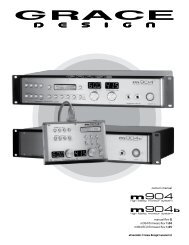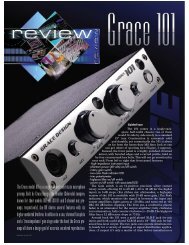model 901 in Pro Audio Review by Tom Jung - Grace Design
model 901 in Pro Audio Review by Tom Jung - Grace Design
model 901 in Pro Audio Review by Tom Jung - Grace Design
- No tags were found...
You also want an ePaper? Increase the reach of your titles
YUMPU automatically turns print PDFs into web optimized ePapers that Google loves.
The Industry’s Equipment AuthorityREPRINTED FROM SEPTEMBER 2002WWW.PROAUDIOREVIEW.COM<strong>Grace</strong> <strong>Design</strong> <strong>901</strong>Headphone Amplifier<strong>by</strong> <strong>Tom</strong> <strong>Jung</strong><strong>Grace</strong> <strong>Design</strong> has earned a reputationfor quality products over the pastfew years with a l<strong>in</strong>e of high-endmicrophone preamplifiers. Ireviewed the 801 eight-channel preamplifier<strong>in</strong> the March/April 1996 issue of PAR andhave s<strong>in</strong>ce used it on many projects.Michael <strong>Grace</strong> has come up with a headphoneamplifier employ<strong>in</strong>g the same passionfor quality as he has for his microphonepreamp designs.FeaturesThe <strong>901</strong> has the same quality look and feelof the <strong>Grace</strong> mic preamps, complete with aprecision gold contact 24-position level controlswitch. Most headphone amplifiers usedual gang potentiometers with track<strong>in</strong>g errorsof several dB, especially at lower ga<strong>in</strong> sett<strong>in</strong>gs.Interchannel track<strong>in</strong>g error can be areal problem affect<strong>in</strong>g both stereo image and<strong>in</strong>ternal balances with the potential of throw<strong>in</strong>goff a mix. With the <strong>901</strong> precision attenuator,channel-to-channel accuracy is ma<strong>in</strong>ta<strong>in</strong>edwith<strong>in</strong> 1/20th of a dB at all ga<strong>in</strong> sett<strong>in</strong>gs!Try that with a pot.The <strong>901</strong> has both balanced XLR andunbalanced RCA analog <strong>in</strong>puts as well asPCM digital <strong>in</strong>puts <strong>in</strong> both AES/EBU andS/PDIF formats, the latter available <strong>in</strong> RCAand TOSl<strong>in</strong>k optical. A back panel m<strong>in</strong>iaturetoggle switch selects between the pro andconsumer formats.The front panel has two centered 1/4-<strong>in</strong>chstereo headphone jacks wired <strong>in</strong> parallel anda large power switch to starboard, ga<strong>in</strong> rangecontrol to the left. The digital/analog pushbuttonsare sealed gold contact relays and areillum<strong>in</strong>ated. Nice. A low distortion 24-bitDAC accepts sample rates up to 96 kHz withfour LEDs <strong>in</strong>dicat<strong>in</strong>g from 32kHz to 96 kHz. The DAC also employs anautomatic digital de-emphasis filter.Like the <strong>Grace</strong> mic preamps, the levelFast FactsApplications:StudioKey Features:24-position ga<strong>in</strong> control;onboard D/A converter; 96kHz performance; XLR, RCA<strong>in</strong>puts; digital <strong>in</strong>puts; consumerand pro operationPrice:$1,495Contact:<strong>Grace</strong> <strong>Design</strong> at 303-443-7454, www.gracedesign.com.control is adjusted with a custom knobmach<strong>in</strong>ed out of solid alum<strong>in</strong>um and isshaped so that from across the room you cantell <strong>by</strong> the angle of the knob where the ga<strong>in</strong> isset. The 24-position ga<strong>in</strong> control is just right,mak<strong>in</strong>g it easy to get back precisely to yourreference sett<strong>in</strong>gs while provid<strong>in</strong>g justenough resolution. In addition, the taper layoutis well thought out. Here is the breakdownof level control taper: fully counterclockwiseis off, the next two steps go from–60 to –50, the next four steps are 4 dB eachand the rema<strong>in</strong><strong>in</strong>g to full up are <strong>in</strong> 2 dB steps.Perfect. The Ga<strong>in</strong> Range switch provides anextra 10 dB of ga<strong>in</strong> for monitor<strong>in</strong>g –10 dBVor consumer level signals. This is also usefulfor low sensitivity headphones.The 3 dB down po<strong>in</strong>ts for frequencyresponse are at 4 Hz and 600 kHz . Of coursethis is <strong>in</strong> the analog mode, which is where Igenerally listen to the <strong>901</strong>. You can be sureDSD signals are not go<strong>in</strong>g to be compromised<strong>by</strong> this k<strong>in</strong>d of bandwidth.Copyright 2002 IMAS Publish<strong>in</strong>g (USA), Inc. Repr<strong>in</strong>ted with permission.
In UseThe <strong>901</strong> uses a high-current output amplifierwith an output impedance of 1 ohm andis capable of driv<strong>in</strong>g 8 ohm loads. Perhapsbecause of its low output impedance, the <strong>901</strong>has the best low-frequency control of anyheadphone amp I have heard. Most headphoneamplifiers have output impedances of100 ohms or more, mak<strong>in</strong>g them potentiallymore bulletproof at the expense of low-frequencycontrol.The <strong>in</strong>ternal high-current l<strong>in</strong>ear power supplyuses a high-current, low-noise, toroidalpower transformer, giv<strong>in</strong>g the <strong>901</strong> just enoughweight so that when you plug and unplugyour headphones you do not have to hold onto the amplifier with your other hand.The signal path is about as pure as youcan get us<strong>in</strong>g high-grade <strong>in</strong>strumentation<strong>in</strong>put amplifiers, high-quality metal filmresistors and no electrolytic capacitors <strong>in</strong> thesignal path.I really liked the sound of the <strong>Grace</strong> <strong>901</strong>.About five seconds after I plugged <strong>in</strong> myGrado HP-1 reference headphones (PAR9/96) I knew this amp was go<strong>in</strong>g to takethese phones to places they had never beenbefore sonically. The first and most obviousarea was the low end. Much of my work<strong>in</strong>cludes acoustic bass, which is traditionallydifficult to reproduce accurately, especiallywith headphones. This is the one area wherereference monitor<strong>in</strong>g on headphones fallsapart due to the fact that most amplifiers donot have good control of the headphonedrivers, caus<strong>in</strong>g low-end boom. This boomcreates a mask<strong>in</strong>g effect that clouds theentire bottom end, mak<strong>in</strong>g it difficult to mixor make tonal adjustments <strong>in</strong> those low-frequencyareas. The <strong>901</strong> has the best bottomendcontrol I have heard. It also seems likemy Grado headphones have another octaveof bass extension.Good bass is not all; the top end has opennessand extension as well with <strong>in</strong>credible harmonicdetail and air. With a DSD signal connectedto the analog <strong>in</strong>puts, the depth andwidth of the soundstage was about as good asI have heard on headphones. The PCM <strong>in</strong>putsare very good as well, with proper analog circuitryfollow<strong>in</strong>g the DAC chip. This makes the<strong>901</strong> an excellent D-to-A reference monitor<strong>in</strong>gdevice. The Grado headphones are about 40ohms and are fairly easy to drive, but the <strong>901</strong>has plenty of power and can drive much lowerimpedances and more difficult loads.SummaryI know of no other headphone amplifierthat performs as well as the <strong>Grace</strong> <strong>901</strong>. At$1,495 the <strong>901</strong> is not cheap, but this k<strong>in</strong>d ofexcellence represents a good <strong>in</strong>vestment ifyou really care about audio quality.<strong>Tom</strong> <strong>Jung</strong>, founder of DMP Records, is<strong>Pro</strong> <strong>Audio</strong> <strong>Review</strong>’s technical consultant anda regular contributor.REVIEW SETUPPhilips SACD-10 PE CD player; EMMLabs DAC8 D/A converter.<strong>Pro</strong>duct Po<strong>in</strong>ts<strong>Grace</strong> <strong>Design</strong> <strong>901</strong>Headphone AmplifierPlus• High-end performance• Quality construction• Useful I/O choicesM<strong>in</strong>us• PriceThe ScoreI know of no other headphoneamplifier that performs as wellas the <strong>Grace</strong> <strong>901</strong>.Copyright 2002 IMAS Publish<strong>in</strong>g (USA), Inc. Repr<strong>in</strong>ted with permission.Repr<strong>in</strong>ted from <strong>Pro</strong> <strong>Audio</strong> <strong>Review</strong>





